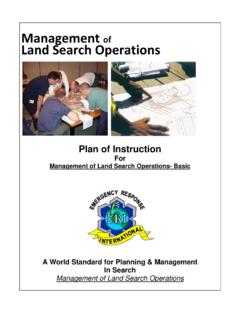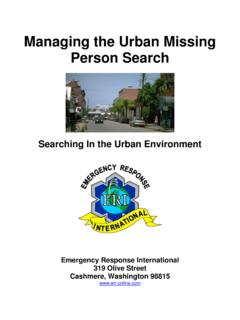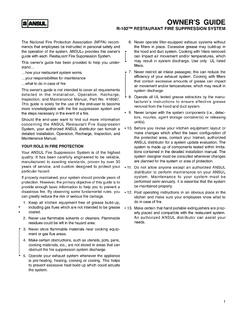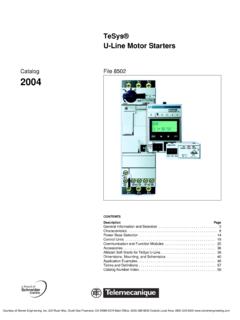Transcription of Basic Search & Rescue Skills - eri-online.com
1 Basic Search & Rescue Skills SAR Skills for the Emergency Responder - Basic Skills and Knowledge - Emergency Response International 319 Olive Street Cashmere, Washington 98815 Basic SAR Skills Training - ERI 3 PLAN OF INSTRUCTION Emergency Response International (ERI) is pleased to provide this Plan of Instruction for a 24+ hour Search and Rescue Basic Skills Course. The course curriculum includes a minimum of 24 hours academic and relevant scenario based practical field training. Maximum number of participants in a training course utilizing two instructors would be 20 students. SAR Skill Training Course Deliverables: Participants who attend this training will become knowledgeable in practices and techniques used in Search and Rescue situations. Students will be exposed to the basics of Search , lost person behavior, tracking, survival Skills , victim packaging, working with aircraft, and other associated Search and Rescue techniques and procedures in isolated and extreme environments.
2 The following topic areas will be covered: The local, state and federal SAR system & how it works Organizational structure for a SAR incident Legal Issues & Public Expectations Clothing & personal protection for Search & Rescue (SAR) operations Environmental hazards in a SAR environment SAR travel Skills , navigation and personal equipment How are available SAR resources used on-scene at an incident Individual and team Search techniques for insured complete coverage Specific SAR tactics and Skills Rope and line Skills Lost person behavior Short term survival Skills Working SAR with aircraft Vectoring & mission communications Procedures to stabilize and package victims during extrication The above specified topic areas are all contained within the modules that make up the syllabus for the ERI training course SAR Skills for the Emergency Responder described below.
3 The Unit Module Descriptions in this Plan of Instruction further identify the deliverables covered in the course. OVERVIEW ERI currently provides all of the component modules described here to law enforcement, Coast Guard and volunteers who have responsibilities in local, state or federal SAR operations. ERI's training, as described here, represents a systematic approach to training SAR Team personnel that provides a thorough orientation to the Skills and knowledge required by emergency responders during SAR operations in the field. The Basic ERI SAR Skills for Emergency Responders is a 3-day (approximately 8 hours per day) course. Our approach to this training provides participants with Basic orientation to subject matter followed by direct application of Skills and knowledge in a practical setting. The course also provides a comprehensive overview of national, state and local SAR response systems, strategies and tactics used by local and state governments as well as other land management jurisdictions.
4 The training course and its accompanying student textbook conform to a Basic SAR training "content standard" advocated across the country. The training provides field Skills and an academic foundation for emergency response in general. The Skills and knowledge apply in both disaster environments as well as single missing person incidents, which operate within the National Incident Management System and Incident Command Structure (NIMS ICS). The emphasis lays a foundation of Skills and knowledge Basic SAR Skills Training - ERI 4 on how to plan for, organize and respond to any Search and Rescue related effort and do the job in the field regardless of the assignment. Participants in this training will quickly blend into any team effort as a valuable resource that is efficient and productive. Academic and practical field skill split is roughly 55% academic/45% practical throughout the course.
5 Background All advanced Skills and capabilities stem from a Basic foundation of knowledge and training. No matter how large a SAR incident response might eventually grow, it all starts with a first responder who applies fundamental Skills and knowledge. Local action correlates directly with what occurs regionally and across the nation. When an EMT rescues a child from an abandoned mine in the South, the Skills and attitudes applied form part of the matrix that makes up emergency response everywhere else around the country. The term SAR really indicates two separate functions; first Search and second Rescue . Rescue utilizes proven procedures along with a high degree of technical skill for victim retrieval. With known victims in known locations, the principle problem involves devising the quickest method of removing that individual from danger to a place of safety and medical aid.
6 On the other hand, Search for missing, lost or injured subjects involves a great deal more. Search and Search planning encompass a sophisticated science involving a great many techniques that include: statistics, probability, human behavior, interviewing, and terrain evaluation coupled with track and clue awareness. These represent but a few of the standard tools used in land Search strategies. SAR training enables the first responder to acquire knowledge, Skills and self-confidence which produce better results in the field during real operations. The foundation of this training builds on a broad body of information from a wide and unprejudiced variety of sources. No course or text reference provides all the answers unto itself, and omissions will surface over time as rookie responders gather more education and experience.
7 However, Basic Search and Rescue Skills training serves as a standard content base for SAR responder development. It should make up the first link in a continuing chain of SAR education and training. Conduct of the Basic Course The first half day of the course sets the academic foundation (rationale, legal requirements and SAR management structures) for the subsequent academic and practical modules. During the remainder of the course, participants will be exposed to mixed academic classroom presentations and practical sessions where students practice Skills and knowledge in an outdoor learning environment. Practical course success starts with interaction between participant and instructor. This means that student to instructor ratio is extremely important. During lecture and discussions, the ratio of instructors to students matters less.
8 However, when it comes to the practical side of the course, one instructor usually works most effectively with 8-10 students for the best interactive process. This ratio provides maximum interaction and personal help with the groups. Generally students ask lots of questions and also ask for assistance during this part of training. We try to keep within the ratio of 8 to 10 students per instructor, particularly with some of the Skills presented. When teaching field Skills , we also find this instructor/student ratio satisfactory to provide good facilitation and interaction between instructors and students. Two instructors will be required for up to 20 students and three instructors will be necessary for any numbers over 20. One instruction area covered in this training is patient packaging and extrication. We want to be very clear about this component.
9 While all of ERI staff are Wilderness First Responders or higher in certification and each is certainly able to teach a survival medicine component to any level required, Basic SAR Skills Training - ERI 5 this part of our training has never been intended to be a Basic or advanced first aid course. In this case, the contemplated timeframe will not allow the required attention on medical issues to qualify it as such. However, virtually every SAR situation includes a medical component for evacuation. Our wilderness medicine protocols for victim packaging and extrication is but one component of the first aid continuum. Our classroom presentations utilize the latest in PowerPoint technology with strategically placed videos and narrative to emphasize true-life case studies and current instruction methods. To the extent possible, the practical field work activities incorporate scenarios and call for both interaction and innovative problem solving by the students.
10 These scenarios require real-world problem solving, and transition into the application of essential Skills for body management and personal protection. Objectives After successful completion of this training course, the participants will have been exposed to the Basic tenets of Search and Rescue for emergency responders and will have the foundational Skills necessary to respond effectively at the local level. Participants will be able to: 1. Define the term Search and Rescue and outline what each of the levels, - local, state and federal does in terms of function, responsibilities and response capability to assist individuals in distress. 2. Describe how the electronic distress systems work in the for emergency beacons to include the commercial beacons ( SPOT), the ELT, EPIRB, and PLB. 3. Discuss and describe the legal responsibilities of both individual emergency responders and the teams or organizations of which they are members.












